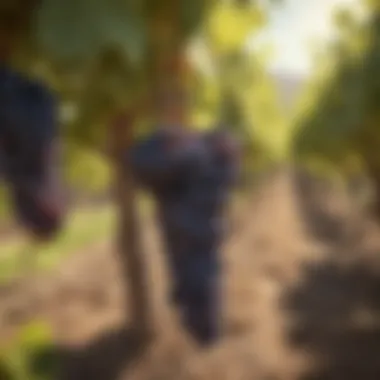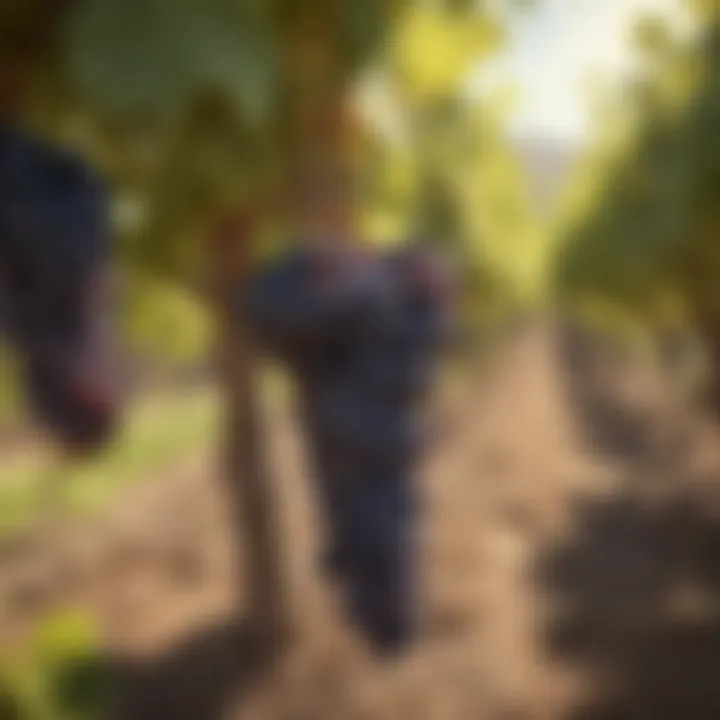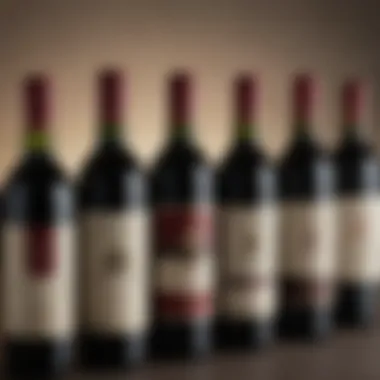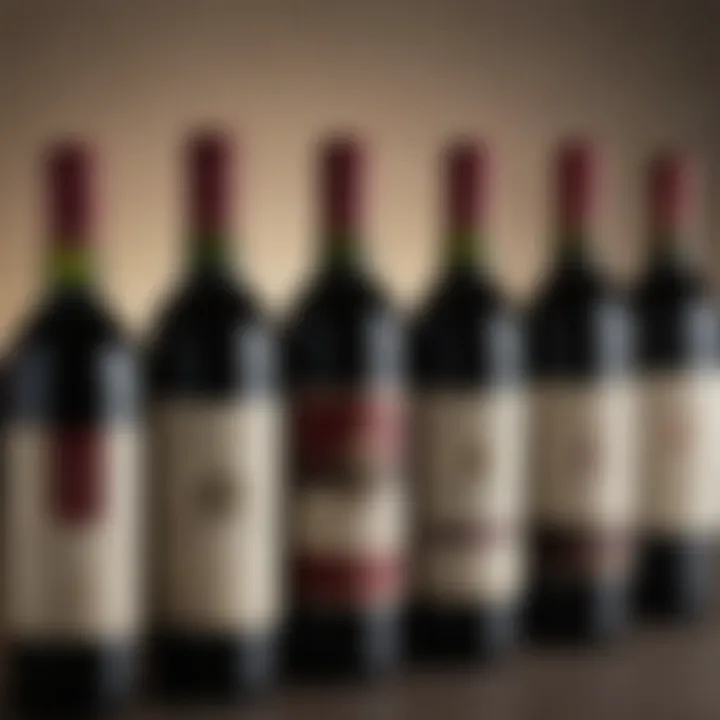Exploring the Depths of Red Cabernet Sauvignon


Intro
Cabernet Sauvignon is often considered the king of red wines. This grape variety has an illustrious history and an unrivaled presence in vineyards around the world. Widely recognized for its deep color, bold flavors, and complex structure, Cabernet Sauvignon is more than just a wine; it is a reflection of its terroir, winemaking practices, and the influence of the climate.
In this exploration, we will delve into the origins of Cabernet Sauvignon, its key characteristics, and the many factors contributing to its esteemed status in the wine community. We will also highlight regional variations, perfect food pairings, and effective tips for selecting and tasting the finest options available.
Understanding Cabernet Sauvignon enriches the drinking experience, whether you are a casual wine drinker or a seasoned connoisseur. This deep dive helps to appreciate the nuances that make this variety a beloved choice for many.
Understanding Cabernet Sauvignon
The topic of Cabernet Sauvignon is crucial in the wine world due to its global reverence and widespread enjoyment. Understanding this varietal is more than just knowledge of its flavor. It involves grasping its history, those who cultivate it, and the methods used to create it. This understanding enhances the wine experience, allowing enthusiasts to appreciate not just the drink but the craftsmanship behind it.
Historical Origins
Cabernet Sauvignon's journey began in the Bordeaux region of France, where it was born as a natural cross between Cabernet Franc and Sauvignon Blanc. This rich legacy dates back to the 17th century. Over the years, it has become a dominant grape variety in many wine regions worldwide. Its symbiosis with diverse climates and soils has enabled it to thrive across continents.
This grape was initially favored for its hardy nature and ability to withstand various climatic challenges. The rise in its popularity in the 20th century can be attributed to the Napa Valley in California, where it cemented its status as a premier wine grape. Additionally, the Bordeaux region remains a key player as well, known for creating benchmarks in the industry.
Botanical Characteristics
From a botanical perspective, Cabernet Sauvignon is notable for its thick skin, which contributes to its bold color and tannin structure. The grape grows in small, dark berries, which cluster tightly. This characteristic size results in juice that has a high concentration of flavor and color, making it ideal for creating full-bodied wines.
The grapevine itself thrives in a variety of terroirs, from rocky slopes to fertile plains. However, it particularly flourishes in well-drained, gravelly soils. The climate also plays a pivotal role. Warm days combined with cool nights help preserve the grape's acidity while enhancing its flavor complexity. The resilience of Cabernet Sauvignon against diseases also adds to its desirability among winemakers, as it requires less intervention during cultivation.
In summary, understanding Cabernet Sauvignon provides insight into its respected place in the wine hierarchy. Knowing its origins and characteristics allows enthusiasts to develop a more nuanced palate and appreciation for this iconic grape.
Key Characteristics of Good Cabernet Sauvignon
In this section, we delve into the key characteristics that define a good Cabernet Sauvignon. Understanding these traits allows both enthusiasts and casual drinkers to appreciate and select quality wines effectively. The characteristics of Cabernet Sauvignon are not just superficial traits; they contribute significantly to the overall experience when tasting and pairing this iconic wine with food.
Flavor Profile
Common Tasting Notes
The common tasting notes found in Cabernet Sauvignon play a crucial role in defining its flavor profile. Predominant flavors such as black currant, plum, and cherry provide the foundational layer of taste. These fruity notes are often complemented by hints of green bell pepper and eucalyptus, adding complexity. Furthermore, many Cabernet Sauvignons exhibit secondary flavors from aging processes, such as vanilla and cedar, imparted by oak barrels.
This varied flavor palette makes Cabernet Sauvignon popular among wine lovers. It is a versatile choice that results in a range of possible experiences, from bold and luscious to elegant and refined. Also, the balance of acidity and tannins enhances its drinkability
- Advantages:
- Disadvantages:
- Offers rich and full-bodied taste
- Pleasing complexity that evolves over time
- Some may find its intensity overwhelming, especially if unfamiliar with strong wines
Variations by Region
The variations by region significantly affect the flavor and aroma of Cabernet Sauvignon, making this wine unique from location to location. For instance, Napa Valley wines are known for their bold fruitiness and high alcohol content. In contrast, Bordeaux wines often display more earthiness and a blend of other varietals, which may soften the fruit flavors but add complexity.
Regional differences stem from climate, soil, and viticultural practices. These factors result in unique expressions of Cabernet Sauvignon that reflect their terroir. This diversity not only enriches the selection for wine enthusiasts but also enhances the overall appreciation for this grape variety as a global staple.
- Advantages:
- Disadvantages:
- Allows for exploration of diverse flavors
- Regional characteristics contribute to distinctive profiles
- Can create confusion due to vast differences in styles
Aroma Attributes
The aroma attributes of Cabernet Sauvignon are essential in shaping the overall tasting experience. An inviting aroma often entices the drinker, setting the stage for the taste to follow. Common aromas include dark fruits, spices, and sometimes floral notes. When exposed to air, Cabernet Sauvignon can reveal layers of complexity.
These aromas contribute greatly to the perception of quality. A pleasing bouquet can indicate a well-crafted wine. Furthermore, recognizing aromatic subtleties can enhance the appreciation for the winemaker's intent and the grape's potential.
Mouthfeel and Structure
The mouthfeel and structure of Cabernet Sauvignon are defining attributes that can elevate or diminish the drinking experience. A robust mouthfeel, characterized by firm tannins, imparts a sense of depth and richness. Many quality Cabernets possess a full-bodied structure that lingers pleasantly on the palate.
Well-crafted Cabernet Sauvignons also maintain good balance, allowing the acidity to refresh the palate, which is essential for food pairings. Understanding these aspects of mouthfeel can aid wine drinkers in selecting the right Cabernet Sauvignon for various occasions. A wine with a smooth finish and well-integrated tannins is often a mark of quality.
"Mouthfeel and structure significantly influence the enjoyment and pairing potential of a wine."
In summary, grasping the key characteristics of good Cabernet Sauvignon is vital for anyone looking to deepen their understanding of this wine. From flavor profiles to aroma and mouthfeel, each aspect plays a role in defining quality and enhancing the overall experience.


Factors Influencing Quality
Understanding the factors influencing the quality of Cabernet Sauvignon is crucial for both wine enthusiasts and producers. These factors not only shape the taste and character of the wine but also determine its overall marketability and value. Among various influences, terroir stands out as a key component. It encompasses the environmental conditions in which the grapes are grown, including soil and climate. Additionally, winemaking techniques play a significant role in transforming the raw fruit into a finished product. By delving into these aspects, one can appreciate the intricate relationships between cultivation practices and wine quality.
Terroir
Terroir, the French term often relating to the unique characteristics of a geographical area, is a fundamental concept in viticulture. It influences the flavors and aromas found in Cabernet Sauvignon. The interplay of soil composition and climate effects sets the stage for each region's distinctive products.
Soil Composition
Soil composition directly impacts the health and development of Cabernet Sauvignon vines. Different soil types contribute varying minerals and nutrients that affect the grape's flavor. For instance, well-drained sandy soils are often favored for their ability to control moisture, promoting healthy vine growth.
The key characteristic of fertile loam soils is their blend of sand, silt, and clay. This mixture allows for both good drainage and nutrient retention, which are critical for vine development. Loamy soils are seen as a beneficial choice in many regions, particularly Napa Valley, where they contribute to the robust flavors typical of high-quality Cabernet Sauvignon.
A unique feature of certain soil compositions is their mineral content. Grapes grown in volcanic soils, for example, may exhibit a distinct mineral-driven flavor profile, which many connoisseurs find appealing. While advantageous, it is important to note that soil composition can also present challenges. Poorly drained soils can lead to overwatering, affecting grape quality negatively.
Climate Effects
Climate effects dictate the growing conditions for Cabernet Sauvignon and have a profound influence on its quality. The climate in which grapes are grown affects the ripening process and the resultant flavor profile. For instance, warmer climates produce grapes with higher sugars, leading to fuller-bodied wines, while cooler climates tend to yield wines with higher acidity, adding freshness.
The key characteristic of climate is its variability. Temperature fluctuations between day and night in certain areas, such as Sonoma County, can enhance the fruit's complexity. This variability is a beneficial aspect since it contributes to a wide range of flavors and aromas, setting apart Cabernet Sauvignon from different regions.
Among unique climatic features, the influence of microclimates cannot be overlooked. Regions with varying elevations can produce distinct characteristics even in neighboring vineyards.
However, there can be disadvantages to specific climate conditions. Unpredictable weather patterns can lead to issues such as frost damage or excessive rainfall during the harvest season, which may adversely affect the quality of the grapes.
Winemaking Techniques
Winemaking techniques are critical in determining the final quality of Cabernet Sauvignon. These practices shape the wine through various processes, from fermentation to aging, and they often distinguish one wine from another.
Fermentation Processes
Fermentation processes are essential for converting grape sugars into alcohol. Within the realm of Cabernet Sauvignon, the choice of fermentation methods can significantly influence the aromatic and flavor profiles of the wine. For example, temperature-controlled fermentation allows for better preservation of the grape's delicate flavors.
A key characteristic of this fermentation process is the use of selected yeasts. Many winemakers opt for specific strains of yeasts that enhance flavor complexities. This is a beneficial technique, contributing to the diverse flavor range found in fine Cabernet Sauvignon wines.
A significant unique feature is the practice of maceration. This involves soaking grape skins with the juice to extract color, tannins, and flavor compounds. However, over-maceration can lead to overly tannic wines, which might not appeal to all drinkers.
Aging Methods
Aging methods complement the fermentation processes by allowing the wine to develop its complexities. Cabernet Sauvignon is traditionally aged in oak barrels, which imbue the wine with additional flavors. The choice between using new or used barrels profoundly impacts the wine's character. New barrels impart strong oaky flavors, while used barrels offer subtler influences.
The key characteristic of aging in oak is its ability to enhance wine structure. Aging allows tannins to soften, contributing to a smoother mouthfeel. This can be a beneficial factor for quality because it often leads to a more balanced finish.
Among unique aging methods, the practice of barrel rotation is becoming popular. This technique helps to evenly distribute flavors throughout the wine. However, extended barrel aging can sometimes overshadow the fruit's inherent characteristics, leading to a less appealing final product.
"The finesse of wine stems not just from the grapes, but from the land and the hands that craft it."
Understanding these factors is essential for anyone looking to select or appreciate good Cabernet Sauvignon. An awareness of terroir, winemaking techniques, and the intricate details involved can significantly elevate one’s experience of this rich and complex wine.
Regional Variations of Cabernet Sauvignon
Understanding the regional variations of Cabernet Sauvignon is crucial for discerning wine enthusiasts. The characteristics of Cabernet Sauvignon can shift dramatically based on where the grapes are grown. Terroir plays a significant role; this includes climate, soil composition, and winemaking traditions. Therefore, knowing these factors enhances the appreciation of this grape variety, allowing for more informed selections depending on personal taste preferences.
California Cabernet Sauvignon
Napa Valley
Napa Valley is renowned for producing some of the highest quality Cabernet Sauvignon in the world. The region's climate, characterized by warm days and cool nights, allows the grapes to develop a complex flavor profile. Napa Cabernet tends to be bold, with rich fruit flavors and firm tannins.
A key characteristic is the region's focus on single varietals, which enhances the uniqueness of its wines. With prestigious wineries like Stag's Leap Wine Cellars and Opus One, Napa Valley remains a premier choice for Cabernet lovers. However, the high demand can lead to elevated prices, which is a consideration for buyers seeking value.
Sonoma County
Sonoma County offers a broader diversity of terroirs than Napa, resulting in a range of styles within its Cabernet Sauvignon. The climate varies significantly due to its proximity to the Pacific Ocean and mountain ranges. This influences flavor, sometimes leading to softer, more approachable wines. Some of the most notable sub-regions include Alexander Valley and Dry Creek Valley.
Sonoma's Cabernet is often praised for its accessibility and often more moderate price points compared to Napa. However, the variability in quality can pose a challenge for those unfamiliar with the region.
French Bordeaux
Left Bank Variants
The Left Bank of Bordeaux is home to some of the oldest and most prestigious Cabernet Sauvignon-based wines in the world. This region, particularly the Médoc, is famous for its blends that often include significant portions of Cabernet Sauvignon.
The key characteristic of Left Bank variations is their structured tannins and age-worthiness, often requiring several years to reach peak maturity. Names like Château Lafite Rothschild exemplify the complexity and nuance that can be found here. The high quality often comes with a high price tag, making these wines more exclusive.
Right Bank Influences


In contrast to the Left Bank, the Right Bank is known for a higher percentage of Merlot in its blends, but Cabernet Sauvignon is still important. Regions like Saint-Émilion and Pomerol offer more approachable wines with softer tannins.
The key characteristic here is fruit-forward profiles with a lush mouthfeel. This makes them appealing for early consumption, yet they can also age well. The diversity in blend composition offers a different perspective on Cabernet, often delighting those who enjoy food-friendly wines.
Global Perspectives
Australian Cabernet Sauvignon
Australia has gained recognition for its distinct style of Cabernet Sauvignon, particularly in regions like Coonawarra and Margaret River. Their unique soil, known as Terra Rossa, contributes to intense fruit flavors and aromatic wines.
The key characteristic of Australian Cabernet is its opulence and ripe fruit notes, often with eucalyptus and mint undertones, distinguishing it from traditional European styles. With competitive pricing and excellent quality, it appeals to those seeking value without sacrificing flavor.
South American Contributions
South America, particularly Chile and Argentina, has emerged as a notable contender in the world of Cabernet Sauvignon. Chilean wines from the Maipo Valley showcase depth and concentration, often with green bell pepper notes.
Argentina has its strengths too, with foothills of the Andes creating ideal growing conditions. Argentinian Cabernet Sauvignon is generally fruitier and often more full-bodied. The key characteristic is a balance that offers both approachability and structure.
These regions provide a unique alternative to more established markets, making them worthy of exploration for any Cabernet enthusiast.
Pairing Cabernet Sauvignon with Food
Pairing Cabernet Sauvignon with food is an essential aspect of fully enjoying this robust wine. Cabernet Sauvignon's complex flavor profile harmonizes well with a variety of dishes. The correct pairings can enhance both the wine and the food, creating an overall better dining experience. Understanding how to pair is not only about personal preference but also about balancing textures and flavors.
When you think of Cabernet Sauvignon, it usually evokes images of rich, savory dishes. The wine's tannins, acidity, and bold flavors work best with specific profiles. It is crucial to consider the intensity of both the wine and the food so that neither overpowers the other. By taking some time to learn about these pairings, one can elevate their enjoyment of Cabernet Sauvignon to another level.
Red Meat Pairings
Cabernet Sauvignon shows its best side when paired with red meats. The wine's tannins complement the proteins, leading to a well-rounded mouthfeel. Meats like steak, lamb, and even game dishes allow the wine to showcase its complexity.
- Grilled Steak: The charred flavors from the grill contrast beautifully with Cabernet's fruitiness.
- Lamb Chops: The richness of the lamb brings forward the wine's deeper notes without being too overwhelming.
- Beef Wellington: This dish, rich and savory, pairs excellently as the wine cuts through the richness.
For these pairings, the key is to ensure that the preparation method enhances the flavors of both the food and the wine, so they can interact harmoniously on the palate.
Vegetarian Options
While Cabernet Sauvignon is often marketed with red meats, it also shows versatility when paired with various vegetarian dishes. It may seem counterintuitive, but great options do exist. Look for dishes featuring earthy and savory notes to mirror the depth of the wine.
- Mushroom Risotto: Earthy mushrooms bring forward the wine's more subtle notes.
- Grilled Vegetables: The slight char on vegetables enhances the wine's fruity character.
- Stuffed Peppers: Made with hearty grains and spices, complementing both Cabernet’s acidity and flavor.
When exploring vegetarian pairings, focus on robust flavors and textures, as they are essential in making a successful match.
Cheese Pairings
Cabernet Sauvignon can also be paired effectively with a range of cheeses, which can highlight the wine's characteristics beautifully. Cheese selection requires attention to the cheese's texture and flavor intensity.
- Aged Cheddar: The sharpness cuts through the wine's tannins providing a delightful contrast.
- Gouda: A sweet, nutty gouda has a creamy texture that complements the wine well.
- Blue Cheese: The boldness of blue cheese stands strong against Cabernet's robust profile, creating a unique balance.
Pairing cheese with Cabernet can be a delightful adventure, introducing new dimensions to both the wine and the cheese.
Remember, the key is exploration! While these pairings are traditional, personal taste plays a significant role.
In sum, the art of pairing Cabernet Sauvignon with food adds another layer of appreciation for this esteemed wine. Each pairing can create a unique experience that enlightens and satisfies.
Selecting Quality Cabernet Sauvignon
Selecting quality Cabernet Sauvignon is a critical aspect for enthusiasts and casual drinkers alike. This process involves understanding various factors that influence the wine’s characteristics and overall quality. The right selection can enhance the wine-drinking experience, allowing you to enjoy the rich flavors and complex aromas associated with good Cabernet Sauvignon. It also positions you for better food pairings and enhances social occasions.
Understanding Labels and Regions
Labels on wine bottles serve as a key guide for consumers. They offer insights into the wine's origin, grape variety, and quality indicators. For Cabernet Sauvignon, knowing how to interpret labels can lead you toward exceptional selections.
When examining a label, pay attention to the following elements:
- Region: The wine’s place of origin significantly affects its flavor profile. Regions like Napa Valley are known for their bold expressions, while Bordeaux offers a more nuanced style.
- Producer: Renowned wineries often employ specific techniques that elevate their Cabernet Sauvignon. Names such as Opus One and Chateau Margaux are synonymous with quality.
- Vintage: This indicates the year of production. Certain years yield better grapes due to favorable climate conditions, impacting the wine’s quality.
Additionally, keep in mind that some regions may have strict regulations governing wine production, ensuring higher standards.
Price Points and Value
Price often reflects the quality of Cabernet Sauvignon, but it is not the only indicator. Understanding price points and their relation to value assists in making informed choices. Here are several considerations:
- Entry-Level Prices: These wines are generally more affordable, starting from $10 to $25. While they may lack complexity, they can still offer enjoyable characteristics.
- Mid-Range Options: Priced between $25 and $75, these selections typically provide richer flavors and greater depth. They often originate from respected producers and regions.
- Premium Selections: Wines over $75 may feature exceptional quality and are from top-rated vintages or prestigious estates. Investing in a premium bottle can lead to a remarkable tasting experience.
When assessing value, consider factors beyond price, such as regional reputation and production methods.
Ultimately, finding good Cabernet Sauvignon involves balancing price with quality indicators derived from labels and regional reputations. This approach ensures a rewarding exploration of this iconic wine.
Tasting Cabernet Sauvignon


Tasting Cabernet Sauvignon is a critical aspect of appreciating this remarkable wine. Understanding the nuances of tasting enhances one’s overall experience and builds a deeper connection with the beverage. The process involves multiple sensory dimensions, from visual cues to olfactory perceptions and taste sensations. Each technique provides insight into the wine's quality, character, and origin, making it essential for both novices and seasoned connoisseurs.
Tasting Techniques
Visual Assessment
Visual assessment involves examining the wine's color, clarity, and viscosity. The hue can offer clues about the wine's age and quality. For instance, a deep red color often indicates a rich and full-bodied wine, while a lighter ruby shade may suggest a more delicate profile. This technique is beneficial as it sets the stage for further exploration.
The unique feature of visual assessment is that it requires no special equipment, making it accessible to everyone. However, lighting plays a crucial role; poor lighting can lead to misinterpretation. In this article, visual assessment becomes an intriguing starting point for understanding Cabernet Sauvignon.
Olfactory Analysis
Olfactory analysis is one of the most vital techniques in the tasting process. It involves swirling the glass to release aromatic compounds, inhaling deeply to identify scents. This technique helps to detect various aromas ranging from fruit notes to earthy undertones. The complexity of aromas in Cabernet Sauvignon makes this method particularly rewarding.
The ability to distinguish different aromas enhances appreciation of the wine and helps in identifying regional characteristics. While everyone's olfactory perception varies, it is a fun and interactive way to engage with Cabernet Sauvignon. Limited by personal fragrance preferences, olfactory analysis remains a cornerstone of wine tasting.
Taste Techniques
Taste techniques focus on the actual flavor experience of the wine. This includes assessing sweetness, acidity, tannins, and body. Understanding how these elements interact can lead to a richer tasting experience. For example, a balanced Cabernet Sauvignon typically reveals harmonious flavors that linger on the palate. This technique is essential for comprehending the wine’s overall profile.
Taste techniques involve a structured approach to sipping and savoring. Swirling the wine in the mouth allows for full recognition of textures and aftertastes. While this technique requires practice, mastering it delivers a profound sense of accomplishment.
Decanting and Aeration
Decanting and aeration play crucial roles in enhancing the tasting experience of Cabernet Sauvignon. Decanting involves transferring the wine from its bottle to a different container, often to separate it from sediment. This process can significantly improve the wine's clarity and overall presentation.
Aeration allows wine to interact with oxygen, which can heighten its aromas and flavors. This is particularly important for younger Cabernet Sauvignons that may initially be tight or closed. As the wine aerates, its bouquet evolves, offering new layers of complexity.
"Allowing Cabernet Sauvignon to breathe can often reveal its full potential, providing a richer tasting experience."
Understanding the right methods for decanting and aeration can dramatically uplift the overall enjoyment. However, it's essential to exercise caution, as over-exposure to air can diminish certain delicate characteristics of the wine.
Tasting Cabernet Sauvignon, with its various techniques, is not just a procedure. It is an enlightening ritual that promotes a greater appreciation for this revered wine. By mastering these elements, one can unlock the secrets of Cabernet Sauvignon and truly enjoy its beauty.
Storing Cabernet Sauvignon
Storing Cabernet Sauvignon correctly is crucial to maintaining its quality and maximizing the enjoyment of this noble wine. Improper storage can lead to rapid degradation of flavors and aromas. Thus, understanding optimal storage conditions, temperature, humidity, and timing is essential. Each detail can significantly influence the wine's longevity and tasting experience.
Optimal Storage Conditions
Temperature Guidelines
Temperature plays a pivotal role in wine storage. The ideal temperature for storing Cabernet Sauvignon is typically between 55°F and 65°F (13°C to 18°C). Within this range, the wine will age gracefully, allowing for the development of complex flavors and aromas.
A cooler temperature can delay the aging process; however, if it is too cold, it can hinder the wine’s ability to mature at all. Alternatively, higher temperatures can accelerate aging, potentially ruining the delicate balance of flavors that Cabernet Sauvignon is known for. Therefore, keeping a consistent temperature is a beneficial practice when storing this wine.
Whether using a wine fridge or a cellar, people often choose a temperature close to 55°F because it helps preserve the wine's integrity over time without compromising its potential. One disadvantage to be aware of is that fluctuations in temperature can negatively impact wine.
Humidity Considerations
Humidity levels are equally important when it comes to storing Cabernet Sauvignon. Ideally, a humidity level between 50-70% is recommended. This range helps maintain the integrity of the cork, which is vital to prevent oxidation. A cork that dries out can lead to air entering the bottle, which negatively affects the wine.
On the other hand, high humidity can lead to mold growth, particularly around labels, which can be unsightly and potentially ruin valuable bottles. Thus, managing humidity is crucial for optimal storage conditions.
Maintaining appropriate humidity can appear daunting, but it is essential to ensure the cork remains sealed. Using a dedicated wine storage system can help regulate both humidity and temperature effectively.
When to Drink
The timing of when to drink Cabernet Sauvignon can vary widely depending on the wine's age and the person's preference. Generally, younger Cabernet Sauvignons are best enjoyed within their first five to ten years. The tannins are more prominent, and the fruit notes are fresh. In contrast, well-aged bottles can provide deeper complexities and softer tannins, making them ideal for savoring after over a decade.
In summary, understanding how to store Cabernet Sauvignon well is essential for enhancing its qualities. Proper temperature, humidity, and timing all lead to a richer experience and appreciation of this classic wine.
A Finale on the Importance of Cabernet Sauvignon
In assessing Cabernet Sauvignon, one must acknowledge its significance in the wine industry. This grape variety is not just a staple; it embodies a potential for complexity and depth that few others can match. The relevance of Cabernet Sauvignon extends beyond its taste and aroma; it represents a cultural legacy and economic importance across many regions. Understanding this wine enriches the experience of both casual drinkers and connoisseurs.
The Continued Popularity
Cabernet Sauvignon has maintained its position as a favored choice among red wines. This popularity can be attributed to its versatile nature. It fits various occasions, from fine dining to casual gatherings. The consistency in quality and the wide range of flavor profiles it offers appeal to many palates. Beyond taste, the marketing of Cabernet Sauvignon also contributes to its popularity. Brands invest in appealing packaging and robust branding, making it widely recognized.
Consumer accessibility is also a key factor. With prices ranging from affordable to premium, there's always a Cabernet Sauvignon for any budget. Many wine clubs and subscriptions now feature these wines prominently, bringing them directly to enthusiasts' doors. This ease of access ensures that Cabernet Sauvignon continues to attract new fans.
"The enduring charm of Cabernet Sauvignon lies in its constant evolution while remaining true to its roots."
Final Thoughts on Quality
When considering the quality of Cabernet Sauvignon, many aspects come into play. Terroir—soil, climate, and location—plays a crucial role in shaping a wine's distinct characteristics. Regions such as Napa Valley and Bordeaux are known for producing exceptional Cabernet Sauvignon, but it can be excellent elsewhere too. Understanding these nuances allows one to appreciate the wine beyond its taste.
Winemaking techniques significantly impact the final product. Techniques such as careful fermentation processes and the choice of aging methods can either enhance or diminish the wine's qualities. It is paramount for enthusiasts to learn about these factors to make informed decisions.







